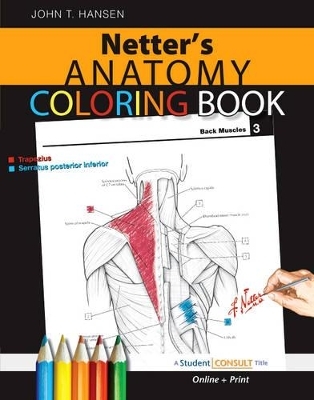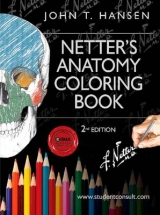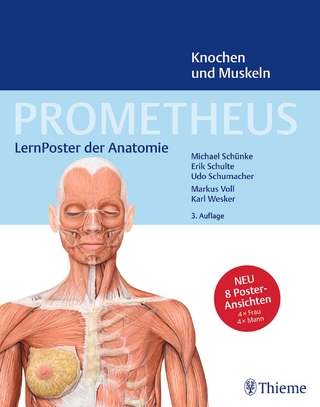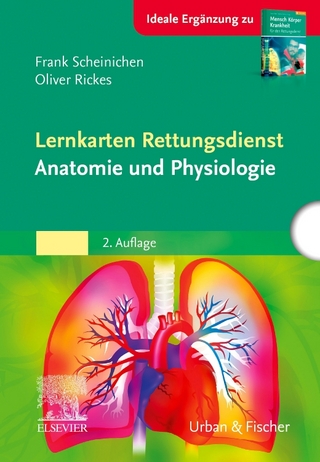
Netter's Anatomy Coloring Book
Saunders
978-1-4160-4702-5 (ISBN)
- Titel erscheint in neuer Auflage
- Artikel merken
Now you can learn and master anatomy with ease, while having fun, through the unique approach of "Netter's Anatomy Coloring Book", by John T. Hansen, PhD. Using this interactive colouring workbook, you can trace arteries, veins, and nerves through their courses and bifurcations...reinforce your understanding of muscle origins and insertions from multiple views and dissection layers...and develop a better understanding of the integration of individual organs in the workings of each body system throughout the human form. Online access to Student Consult - where you'll find the complete contents of the book and much more - further enhances your study and exponentially boosts your reference power. Whether you are taking an anatomy course or just curious about how the body works, let the art of Netter guide you!
John Hansen is Professor Emeritus, a recent past-Chair for Medical Education in Neurobiology and Anatomy, and Associate Dean for Admissions at the University of Rochester School of Medicine and Dentistry. Dr. Hansen was awarded the first annual Presidential Diversity Award by the University of Rochester in recognition of his 24 years of commitment and dedicated efforts to increase the recruitment, retention and graduation of medical school candidates from diverse backgrounds. Dr. Hansen, researches peripheral and central dopaminergic systems, neural plasticity and neural inflammation. He is a recipient of an NIH Research Career Development Award and has received numerous teaching awards including Alpha Omega Alpha Robert J. Glaser Distinguished Teacher Award given annually by the AAMC to nationally recognized medical educators. Professor Hansen is author of over 110 research publications, book chapters, and books. He has been Co-editor of the journal Clinical Anatomy and the lead consulting editor of Netter's Atlas of Human Anatomy (2-7th editions). He continues to author Netter's Anatomy Flash Cards and Netter's Clinical Anatomy in addition to this coloring book.
Chapter 1: Orientation and Introduction 1.1.Terminology 1.2.Body Planes and Terms of Relationship 1.3.Movements 1.4.The Cell 1.5.Epithelial Tissues 1.6.Connective Tissues 1.7.Skeleton 1.8.Joints 1.9.Synovial Joints 1.10.Muscle 1.11.Nervous System 1.12.Skin (Integument) 1.13.Body Cavities Chapter 2: Skeletal System 2.1.Bone Structure and Classification 2.2.External Features of the Skull 2.3.Internal Features of the Skull 2.4.Mandible and Temporomandibular Joint 2.5.Vertebral Column 2.6.Cervical and Thoracic Vertebrae 2.7.Lumbar, Sacral and Coccygeal Vertebrae 2.8.Thoracic Cage 2.9.Joints and Ligaments of the Spine 2.10.Pectoral Girdle and Arm 2.11.Shoulder Joint 2.12.Forearm and Elbow Joint 2.13.Wrist and Hand 2.14.Wrist and Finger Joints and Movements 2.15.Pelvic Girdle 2.16.Hip Joint 2.17.Thigh and Leg Bones 2.18.Knee Joint 2.19.Bones of the Ankle and Foot 2.20.Ankle and Foot Joints Chapter 3: Muscular System 3.1Muscles of Facial Expression 3.2Muscles of Mastication 3.3Extraocular Muscles 3.4Muscles of the Tongue and Palate 3.5Muscles of the Pharynx and Swallowing 3.6Intrinsic Muscles of the Larynx and Phonation 3.7Muscles of the Neck 3.8Prevertebral Muscles 3.9Superficial and Intermediate Back Muscles 3.10Deep (Intrinsic) Back Muscles 3.11Thoracic Wall Muscles 3.12Anterior Abdominal Wall Muscles 3.13Muscles of the Male Inguinal Region 3.14Muscles of the Posterior Abdominal Wall 3.15Muscles of the Pelvis 3.16Muscles of the Perineum 3.17Posterior Shoulder Muscles 3.18Anterior Shoulder Muscles 3.19Arm Muscles 3.20Pronation and Supination of the Radioulnar Joints 3.21Anterior Forearm Muscles 3.22Posterior Forearm Muscles 3.23Intrinsic Hand Muscles 3.24Summary of Upper Limb Muscles 3.25Gluteal Muscles 3.26Posterior Thigh Muscles 3.27Anterior Thigh Muscles 3.28Medial Thigh Muscles 3.29Anterior and Lateral Leg Muscles 3.30Posterior Leg Muscles 3.31Intrinsic Foot Muscles 3.32Summary of Lower Limb Muscles Chapter 4: Nervous System 4.1.Neuronal Structure 4.2.Glial Cells 4.3.Types of Synapses 4.4.Cerebrum 4.5.Cortical Connections 4.6.Midsagittal and Basal Brain Anatomy 4.7.Basal Ganglia 4.8.Limbic System 4.9.Hippocampus 4.10.Thalamus 4.11.Hypothalamus 4.12.Cerebellum 4.13.Spinal Cord I 4.14.Spinal Cord II 4.15.Spinal and Peripheral Nerves 4.16.Dermatomes 4.17.Brain Ventricles 4.18.Subarachnoid Space 4.19.Sympathetic Division of the ANS 4.20.Parasympathetic Division of the ANS 4.21.Enteric Nervous System 4.22.Cranial Nerves 4.23.Visual System I 4.24.Visual System II 4.25.Auditory and Vestibular Systems I 4.26.Auditory and Vestibular Systems II 4.27.Taste and Olfaction 4.28.Cervical Plexus 4.29.Brachial Plexus 4.30.Lumbar Plexus 4.31.Sacral Plexus Chapter 5: Cardiovascular System 5.1.Composition of Blood 5.2.General Organization 5.3.Heart I 5.4.Heart II 5.5.Heart III 5.6.Heart IV 5.7.Features of Arteries, Capillaries and Veins 5.8.Head and Neck Arteries 5.9.Arteries of the Brain 5.10.Veins of the Head and Neck 5.11.Arteries of the Upper Limb 5.12.Arteries of the Lower Limb 5.13.The Thoracic and Abdominal Aorta 5.14.Arteries of the Gastrointestinal Tract 5.15.Arteries of the Pelvis and Perineum 5.16.Veins of the Thorax 5.17.Veins of the Abdominopelvic Cavity 5.18.Portocaval Anastomoses 5.19.Veins of the Upper Limb 5.20.Veins of the Lower Limb Chapter 6: Lymphatic System 6.1.General Organization of the Lymphatic System 6.2.Innate Immunity 6.3.Adaptive Immunity 6.4.Thymus and Bone Marrow 6.5.Spleen 6.6.Tonsils, BALT, GALT and MALT 6.7.Clinical Aspects of the Lymphatic System Chapter 7: Respiratory System 7.1.Overview 7.2.Nasal Cavity and Nasopharynx 7.3.Paranasal Sinuses 7.4.Oropharynx, Laryngopharynx and Larynx 7.5.Trachea and Lungs 7.6.Respiratory Mechanisms Chapter 8: Gastrointestinal System 8.1 Overview 8.2 Oral Cavity 8.3 Teeth 8.4Pharynx and Esophagus 8.5 Peritoneal Cavity and Mesenteries 8.6 Stomach 8.7 Small Intestine 8.8Large Intestine 8.9 Liver 8.10 Gallbladder and Exocrine Pancreas Chapter 9: Urinary System 9.1 Overview of the Urinary System 9.2 Kidney 9.3 Nephron 9.4 Renal Tubular Function 9.5 Urinary Bladder and Urethra Chapter 10: Reproductive System 10.1 Overview of the Female Reproductive System 10.2 Ovaries and Uterine Tubes 10.3 Uterus and Vagina 10.4 Menstrual Cycle 10.5 Female Breast 10.6 Overview of the Male Reproductive System 10.7 Testis and Epididymis 10.8 Male Urethra and Penis Chapter 11: Endocrine System 11.1 Overview 11.2 Hypothalamus and Pituitary Gland 11.3 Pituitary Gland 11.4 Thyroid and Parathyroid Glands 11.5 Adrenal Glands 11.6 Pancreas 11.7 Puberty 11.8 Digestive System Hormones
| Reihe/Serie | Netter Basic Science |
|---|---|
| Zusatzinfo | Approx. 160 illustrations |
| Verlagsort | Philadelphia |
| Sprache | englisch |
| Maße | 216 x 276 mm |
| Themenwelt | Studium ► 1. Studienabschnitt (Vorklinik) ► Anatomie / Neuroanatomie |
| ISBN-10 | 1-4160-4702-6 / 1416047026 |
| ISBN-13 | 978-1-4160-4702-5 / 9781416047025 |
| Zustand | Neuware |
| Haben Sie eine Frage zum Produkt? |
aus dem Bereich



